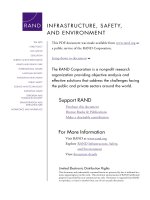OIL REFINING PROCESSES ver1
Bạn đang xem bản rút gọn của tài liệu. Xem và tải ngay bản đầy đủ của tài liệu tại đây (9.94 MB, 97 trang )
OIL
REFINING
PROCESSES
Advanced
course
Assoc.Prof.
Pham
Huyen
References
• Chang
Samuel
Hsu
and
Paul
R.
Robinson,
Practical
Advances
in
Petroleum
Processing,
Vol 1,
Springer,
2006
• Mohamed
A.
Fahim,
Taher A.
Alsahhaf and
Amal Elkilani,
Fundamentals
of
Petroleum
Refining,
Elsevier,
2010
Outline
Unit
1.
Introduction
Unit
2.
Refinery
Feedstocks and
Products
Unit
3.
Modern
Petroleum
Processing
Unit
4.
Auxiliary
Processes
&
Utilities
Unit
1.
Introduction
Largest Worldwide Refineries
Approximately
650 Refineries in
the world
Source: Oil & Gas Journal
Unit
1.
Introduction
• High sulfur, heavy crude is lowest cost.
àRequires extremely complex
refinery to convert into high value
products.
• Low sulfur, light crude is highest cost.
à Simple refining yields high value
products.
• a function of location of crude supply
versus refining centers.
à Refiners close to crude production
enjoy advantage over refineries
distant from supply
Unit
1.
Introduction
Unit
1.
Introduction
Note:
product
blending
and
sulfur
recovery
units
are
not
shown,
but
these
are
almost
always
present
Unit
1.
Introduction
• DQR
Introduction
• NSRP
Introduction
Unit
2.
Refinery
Feedstocks and
Products
2.1.
Composition
of
Crude
Oils
2.2.
Products
Composition
2.3.
Physical
Property
Characterization
Data
2.4.
Chemical
Analysis
Data
2.1.
Composition
of
Crude
Oils
Impurities
(sulphur,
nitrogen,
oxygen
and
metals):
-‐ low
concentrations
-‐ undesirable
-‐ affect
the
quality
of
the
produced
products
-‐ Catalyst
poisoning
and
corrosion
2.1.
Composition
of
Crude
Oils
Hydrogen
to
carbon
ratios
affect
the
physical
properties
of
crude
oil.
-‐ As the hydrogen to carbon ratio decreases, the gravity and boiling
point of the hydrocarbon compounds increases.
-‐ the
higher
the
hydrogen
to
carbon
ratio
of
the
feedstock,
the
higher
its
value
is
to
a
refinery
because
less
hydrogen
is
required.
2.1.
Composition
of
Crude
Oils
2.1.
Composition
of
Crude
Oils
Hydrocarbons:
-‐ Paraffins
-‐ Olefins are
not
naturally
present
in
crude
oils
but
they
are
formed
during
the
conversion
processes
-‐ Naphthenes (cycloalkanes):
Mutli-‐ring
naphthenes are
present
in
the
heavier
parts
of
the
crude
oil
-‐ Aromatics
Polynuclear aromatic
compounds
are
found
in
the
heavy
petroleum
cuts
à cause
catalyst
deactivation
and
coke
deposition
during
processing
à environmental
problems
2.1.
Composition
of
Crude
Oils
2.1.
Composition
of
Crude
Oils
-‐ Sulphur Compounds
• varies
from
less
than
0.05
to
more
than
10
wt%
(but
generally
falls
in
the
range
1–4
wt%).
• Crude
oil
with
less
than
1
wt%
sulphur is
referred
to
as
low
sulphur or
sweet,
and
that
with
more
than
1
wt%
sulphur is
referred
to
as
high
sulphur or
sour.
• Sulphur heteroatoms
• inorganic
forms:
elemental
sulphur S,
dissolved
hydrogen
sulphide
H2S,
carbonyl
sulphide
COS
• organic
forms:
mercaptans and
sulphides,
Sulphides and
disulphides,
Thiophenes
2.1.
Composition
of
Crude
Oils
-‐ Oxygen
Compounds
• less
than
2
wt%.
• include
alcohols,
ethers,
carboxylic
acids,
phenolic
compounds,
ketones,
esters
and
anhydrides.
• causes
the
crude
to
be
acidic
with
consequent
processing
problems
such
as
corrosion.
2.1.
Composition
of
Crude
Oils
-‐ Nitrogen
Compounds
• Crude
oils
contain
very
low
amounts
of
nitrogen
compounds.
• the
more
asphaltic
the
oil,
the
higher
its
nitrogen
content.
• more
stable
than
sulphur compounds
à harder
to
remove.
• be
responsible
for
the
poisoning
of
a
cracking
catalyst,
and
contribute
to
gum
formation
in
finished
products.
• The
nitrogen
compounds
in
crude
oils
may
be
classified
as
basic
or
non-‐basic.
• Basic
nitrogen
compounds:
pyridines.
• Non-‐basic
nitrogen
compounds:
pyrrole types.
2.1.
Composition
of
Crude
Oils
-‐ Metallic
Compounds
•
•
•
•
•
•
•
•
exist
in
all
crude
oil
types
in
very
small
amounts
cause
operational
problems
and
contaminate
the
products,
affect
upgrading
processes
cause
poisoning
to
the
catalysts used
for
hydroprocessing and
cracking.
small
amounts
of
metals
(iron,
nickel
and
vanadium)
in
the
feedstock
to
the
catalytic
cracker
affect
the
activity
of
the
catalyst
à increased
gas
and
coke
formation
and
reduced
gasoline
yields.
For
high-‐temperature
power
generators,
the
presence
of
vanadium
in
the
fuel
may
lead
to
ash
deposits on
turbine
blades
and
cause
severe
corrosion,
and
the
deterioration of
refractory
furnace
linings.
inorganic
water-‐soluble
salts,
mainly
as
chlorides
and
sulphates of
sodium,
potassium,
magnesium
and
calcium
à removed
in
desalting
operations.
oil-‐soluble
organometallic
compounds:
Zinc,
titanium,
calcium
and
magnesium
appear
in
the
form
of
organometallic
soaps.
oil-‐soluble
compounds:
vanadium,
nickel,
copper
and
iron
àcomplexing with
pyrrole compounds.
2.1.
Composition
of
Crude
Oils
-‐ Asphaltenes:
-‐ condensed
polynuclear aromatic
layers
linked
by
saturated
links,
-‐ lead
to
coke
formation
and
metal
deposition
on
the
catalyst
surface
causing
catalyst
deactivation.
-‐ Resins
-‐ polar
molecules
in
the
molecular
weight
range
of
500–1000,
-‐ insoluble
in
liquid
propane
but
soluble
in
n-‐heptane.
-‐ responsible
for
dissolving
and
stabilizing
the
solid
asphaltene molecules
in
petroleum.
The
resin
molecules
surround
the
asphaltene clusters
(micelles)
and
suspend
them
in
liquid
oil.
Because
each
asphaltene is
surrounded
by
a
number
of
resin
molecules,
the
content
of
resins
in
crude
oils
is
higher
than
that
of
the
asphaltenes.
2.2.
Products
Composition
-‐ Liquefied
Petroleum
Gas
(LPG)
-‐ Gasoline
-‐ Kerosene
-‐ Jet
Fuel
-‐ Diesel
Fuel
-‐ Fuel
Oil
(Residual
Fuel
Oil)
-‐ Lube
Oil
-‐ Asphalt
-‐ Petroleum
Coke
2.2.
Products
Composition
2.2.
Products
Composition
2.2.
Products
Composition









